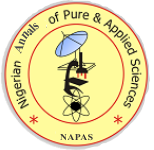Molecular Diversity of Candida albicans Isolated from High Vaginal Swab of Patients Attending Health Care Facilities in Nasarawa State, Nigeria
DOI:
Keywords:
Candidiasis, CLSI, RapID Yeast Plus System (R8311007) Kits, RFLP, HVS, Candida albicansAbstract
Candida albicans (C. albicans) has been a major causative agent of candidiasis. This study, looked at the molecular diversity of C. albicans associated with vaginal infections in Nasarawa State, Nigeria. A total of one thousand two hundred (1200) High Vaginal Swabs (HVS) samples were collected across the senatorial zones in Nasarawa State namely; Nasarawa North (NN), Nasarawa South (NS) and Nasarawa West (NW). The C. albicans were isolated, identified and confirmed by methods as described by Clinical and Laboratory Standards Institute (CLSI) including; RapID Yeast Plus System (R8311007) kits, genomic DNA was extracted using the quick Protocle (ZR Fungal DNA miniPrep) DNA extraction kit and Restriction Fragment Length Polymorphism (RFLP) analysis; Eight oligonucleotides i.e. Primers1(5'-GGGGGTTAGG-3'), 2(5'-GGTGTAGTGT-3'), 3(5'-GTATTGGGGT-3'), 4(5'-GGTTCTGGCA-3'), 5(5'-AGGTCACTGA-3'), 6(5'-AAGGATCAGA-3'),7(5'-CACATGCTTG-3'), and 8 (5'-TAGfATCAGA-3') were used, the forward (ITS1) and reverse (ITS2: 5'-GCTGCGTTCTTCATCGATGC-3') primers and the forward (ITS3: 5'-GCATCGATGAAGAACGCAGC-3') and ITS4 primers were used for amplification of ITS1 and ITS2 regions, respectively. The amplicons of each region for individual yeast isolate was mixed and subjected to agarose gel electrophoresis. Species identification was based on the unique pattern for each species. Out of 1200 swab samples obtained and analyzed across the Senatorial zones, a total of 144 (12%) were C. albicans positive. In relation to Senatorial zone, each zone had; Nasarawa North (NN) 3.8%, Nasarawa South (NS) 4.2% and Nasarawa West (NW) 4.0%. the RFLP analysis showed that all of the isolates had molecular band weight of 50bp-100bp, with some having other molecular band weights. Eight strains of C. albicans strains A, B, C, D, E, F, G and H were identified. In addition, the distribution of C. albicans strains A and E as while as B and H were 50.0% and 25.0% respectively.
References
Agada E.O, Ishaieku, D and Ngwai, Y.B (2017). Incidence and susceptibility of Candida albicans among pregnant women attending antenatal care in Keffi, Nigeria. African Journal of Natural and Applied Sciences, Vol 5(2) 95 - 103
Babic, C and Hukie, M. (2010): Candida albicans and Non-albicans species as etiological agents in pregnant and non-pregnant women. Bosnian Journal of Medical Sciences 10(1)111
Bonfim-Mendonça,P.S Fiorini A, Shinobu-Mesquita, C.S and Baeza LC(2013). Molecular typing of Candida albicans isolates from hospitalized patients. Revista do Instituto de Medicina Tropical de São Paulo. 55 (6), 385-391
Borman A.M, Szekely A, Linton C.J, Palmer M.D, Brown P, and Johnson E.M (2008). “Epidemiology, antifungal susceptibility, and pathogenicity of Candida africana isolates from the United Kingdom,” Journal of Clinical Microbiology, 51 (3), 967972.
Criseo G, Scordino F, and Romeo O (2015). “Current methods for identifying clinically important cryptic Candida species,” Journal of Microbiological Methods, 111, 5056.
Feng X, Wu Z and Ling B (2014). “Identification and differentiation of Candida parapsilosis complex species by use of exon-primed intron-crossing PCR,” Journal of Clinical Microbiology, 52, (5), 17581761.
Giovanni R, Fiori A, Luisa F, López F, Gómez B.L, Parra-Giraldo C.M, Gómez-López A, Suárez C.F, Ceballos A, Van Dijck P and Patarroyo M.A (2015). “Characterising atypical Candida albicans clinical isolates from six third-level hospitals in Bogotá, Colombia, BMC Microbiology, 15: 199
Li J, Fan J.S and Liu X.P (2008). “Biased genotype distributions of Candida albicans strains associated with vulvovaginal candidosis and candidal balanoposthitis in China,” Clinical Infectious Diseases, 47 (9): 11191125.
Lisboa C, Santos A, Dias C, Azevedo F, Pina-Vaz C, and Rodrigues A (2010). “Candida balanitis: risk factors,” Journal of the European Academy of Dermatology and Venereology, 24 (7): 820826.
Mirhendi H, Muhamoodi M, Kordbacheh P, Hashemi S.J, and Moazeni M ( 2010). Species Identification and Strain Typing of Candida Isolates by PCR-RFLP and RAPD-PCR Analysis for Determining the Probable Sources of Nosocomial Infections. Iranian Red Crescent Medical Journal , 12 (5): 539-547.
Muriel C, Boualem S, Chantal F, Claude G, Daniel P, and Huu-Vang N (2011). Molecular Identification of Closely Related Candida Species Using Two Ribosomal Intergenic Spacer Fingerprinting Methods. Journal of Molecular Diagnostics; 13 (1): 1222
Nnadi E N, Ayanbimpe N G, Scordino F, Okolo M O, Enweani I B, Criseo G and Orazio R (2012).Isolation and molecular characterization of Candida africana from Jos, Nigeria Medical Mycology; 50: 765767.
Nsofor C. A, Cynthia E. O and Chika V. O. (2016). High Prevalence of Candida albicans
Observed in Asymptomatic Young Women in Owerri, Nigeria.Biomedicine and Biotechnology. 4 (1): 1- 4
Ochei, J and Kolhatkar, A.A. (2000): Medical Laboratory Science Theory and Practice. TataMacCraw- Hill publising Companies New Delhi. PP 1007 1107
Rather S. (2005): Antifungal susceptible of Candida vulvovaginalitis and epidemiology of recurrent cases. Journal of Clinical Microbiology 43(3): 2155-2162.
Romeo O and Criseo G (2011). “Candida africana and its closest relatives,” Mycoses, 54 (6): 475486.
Sapkota AR, Morenike E C, Rachel E R G, Nancy L A, Shauna J Set, Priscilla O S, Modupe T O, Elizabeth O, Olayemi O A, Olufunmiso O O, Laura S, Paul S P and Kayode K O (2010). Self-medication with antibiotics for the treatment of menstrual symptoms in southwest Nigeria: across-sectional study. BMC Public Health10:610
Sharma C, Muralidhar S, Xu J, Meis J.F, and Chowdhary A (2014) “Multilocus sequence typing of Candida africana from patients with vulvovaginal candidiasis in New Delhi, India,” Mycoses, 57 (9): 544552.
Shruti Singh (2014). Molecular-Genetic Approaches for Identification and Typing of Pathogenic Candida Yeasts: A Review. International Journal of Innovative Research in Science, Engineering and Technology, 3 (9).
Tietz H.-J, Hopp M, Schmalreck A, Sterry W and Czaika V (2001). “Candida africana sp. a new human pathogen or a variant of Candida albicans/” Mycoses, 44 (11&12): 437445.
Umeh SO, and Emelugo B.N (2011). Incidence of Candida albicans infection among women having cases of vaginal itching and discharge in Awka Anambra state, Nigeria. Trop J Medical Research, 11 : 9 11.
Wahyuningsih R, Freisleben H.J, Sonntag H.G and Schnitzler P (2000). Simple and Rapid Detection of Candida albicans DNA in Serum by PCR for Diagnosis of Invasive Candidiasis Journal of Clinical Microbiology. 38 (8): 30163021.
Wanjie Y, Xiaolong K, Qingfeng Y, Yao L and Meiying F (2013). Review on the development of genotyping methods for assessing farm animal diversity. Journal of Animal Science. 4(2):
Yang H, Yu A, Chen X, Wang G, and Feng X (2015). “Molecular Characterization of Candida africana in Genital Specimens in Shanghai, China.” BioMed Research International 5.
Downloads
Published
How to Cite
Issue
Section
License
Copyright (c) 2021 Agada EO, YB Ngwai, TT Sar

This work is licensed under a Creative Commons Attribution-ShareAlike 4.0 International License.



 Contact Us
Contact Us Editorial Team
Editorial Team Join As A Reviewer
Join As A Reviewer  Request For Print Copy
Request For Print Copy


 Cprint Publishers
Cprint Publishers